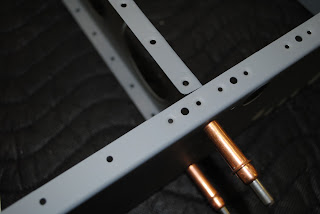Today I finished riveting the left step floor in place. I then prepped the rear baggage bulkhead for installation. I deburred the edges and the lightening holes and dimpled the upper edge for the nutplates. I then dimpled the nutplates and riveted them in place.
I separated the auto pilot servo brackets and along with the facet pump mounting bracket prepped the parts for priming. I then primed them.
I riveted the rear bulkhead and servo brackets in place and installed the snap bushings.
I clecoed the facet pump bracket in place and final drilled the 4-corner holes. I then prepped and riveted the nutplates to the inside of the bracket and then riveted it in place on the bottom skin of the fuselage.
I inserted the machine screws through the bottom skin for the system blocks and started the nuts onto the bolts. I will need some assistance in tightening the lock nuts all of the way onto the screws.




















































